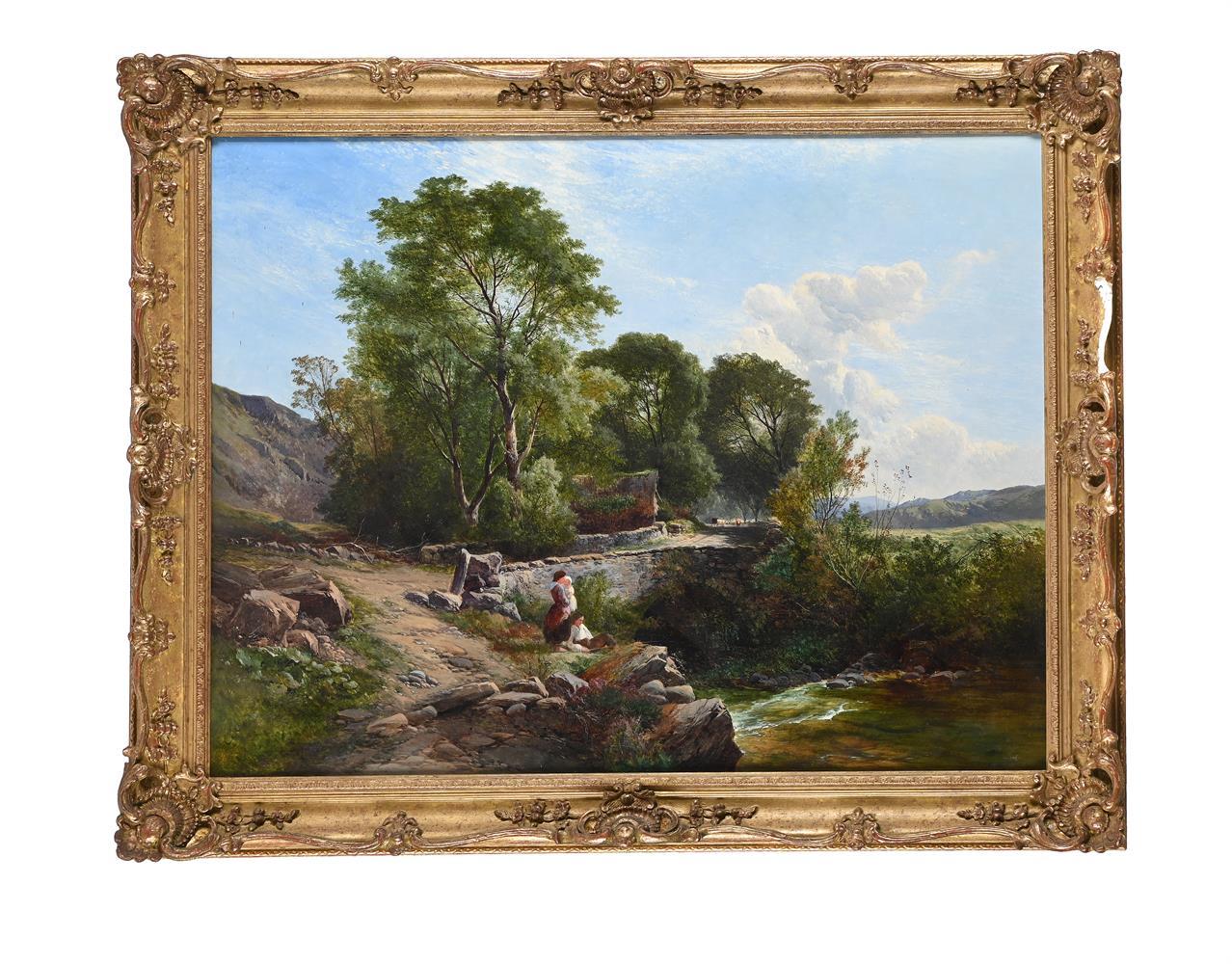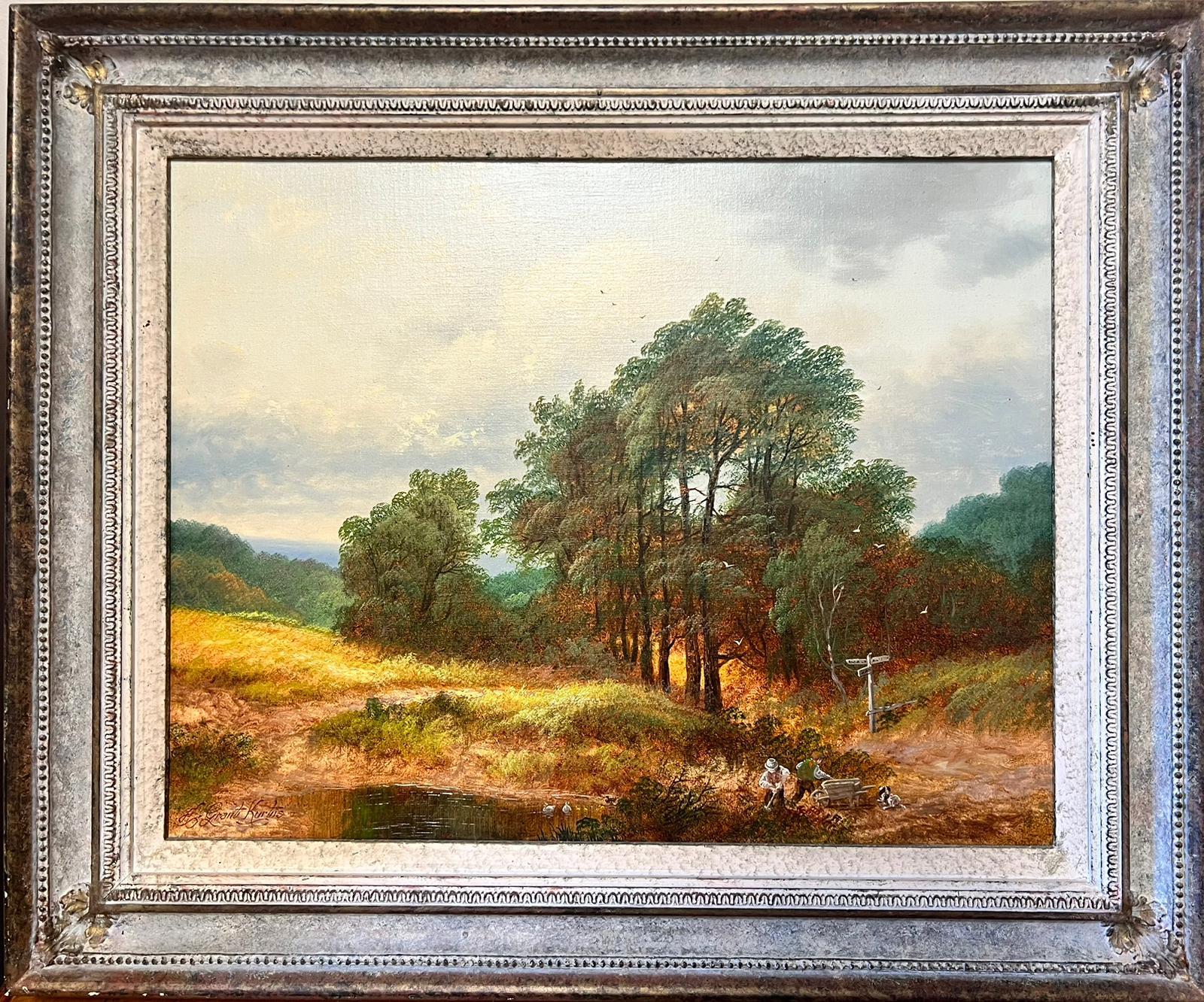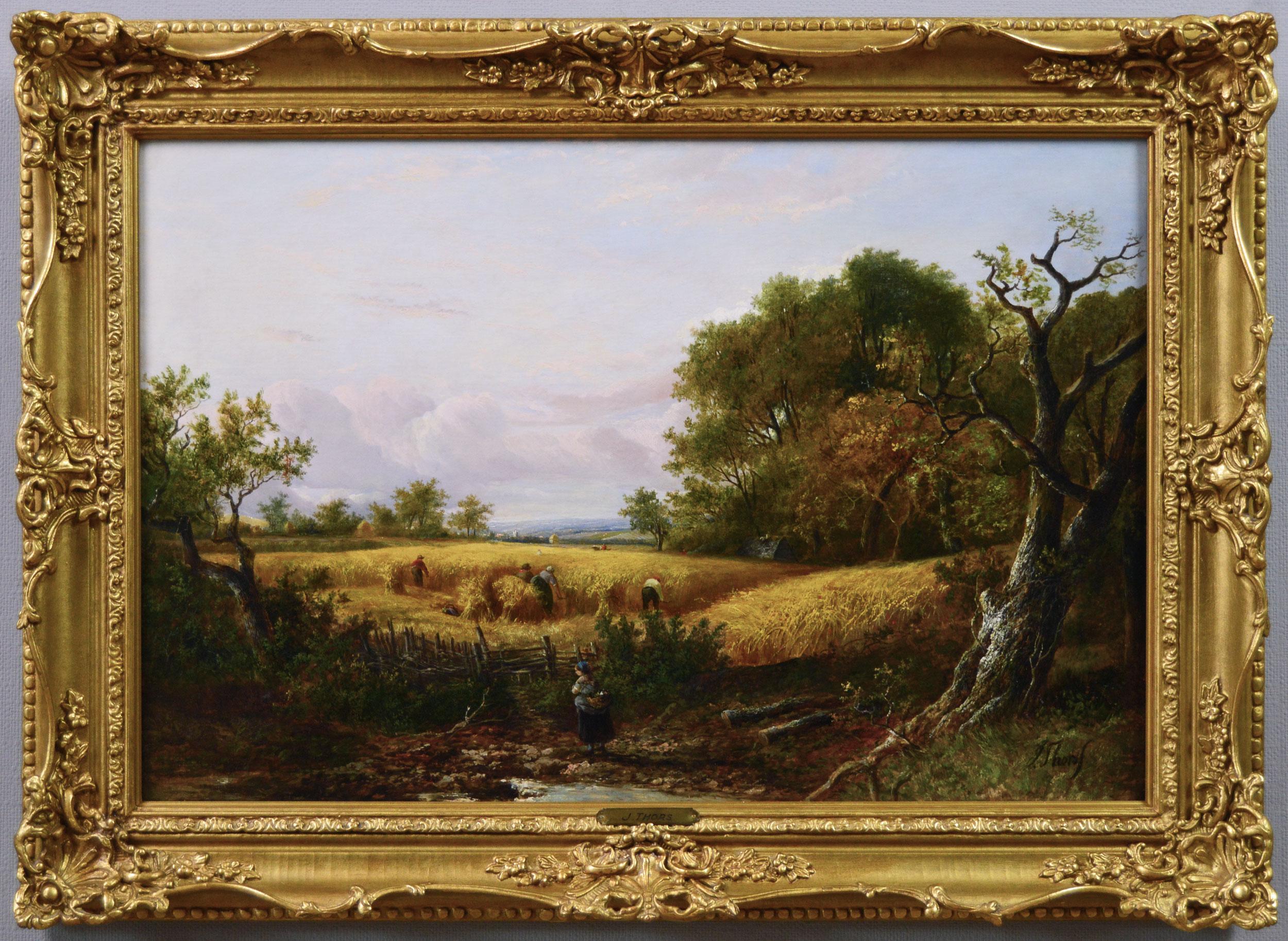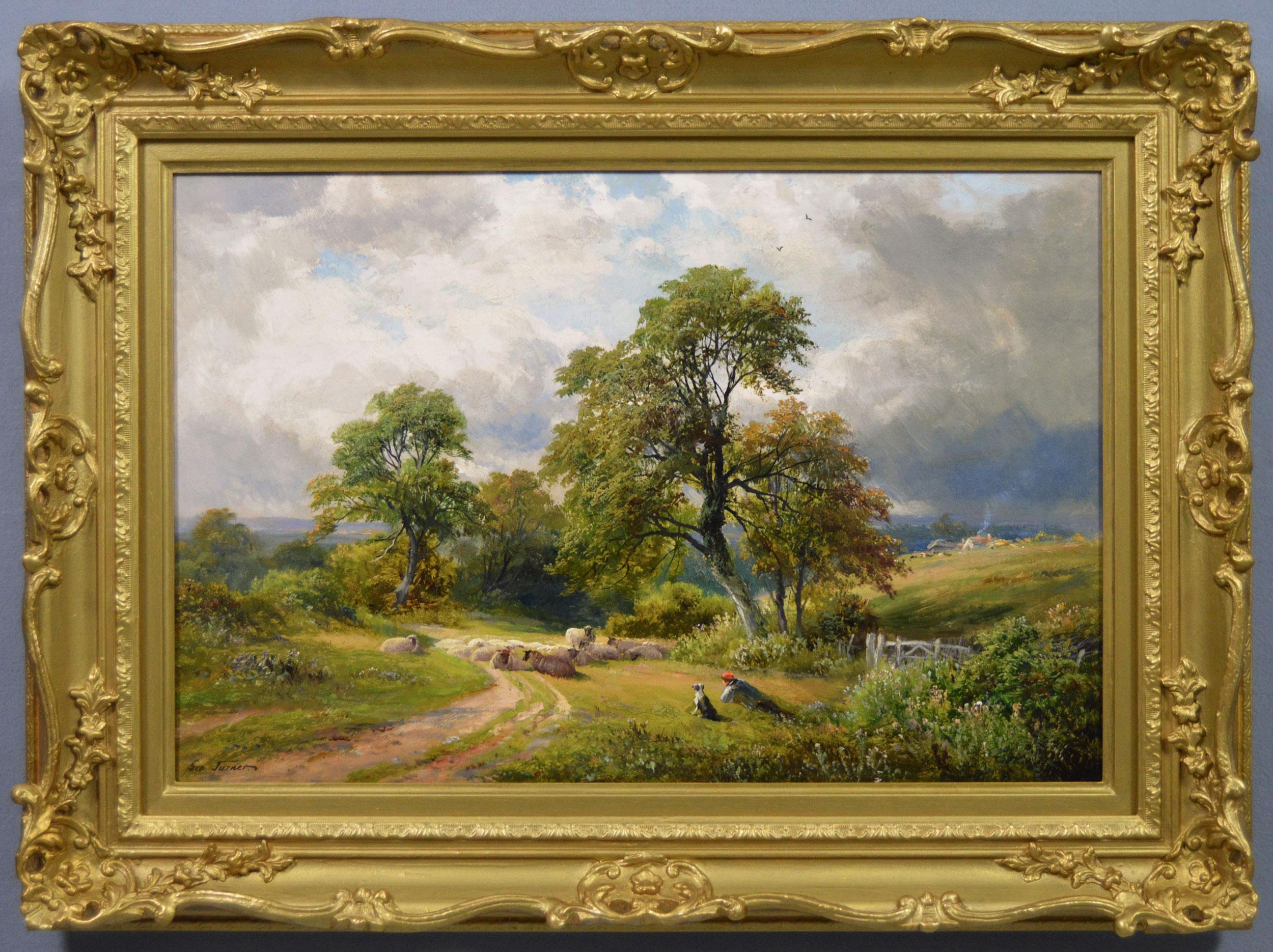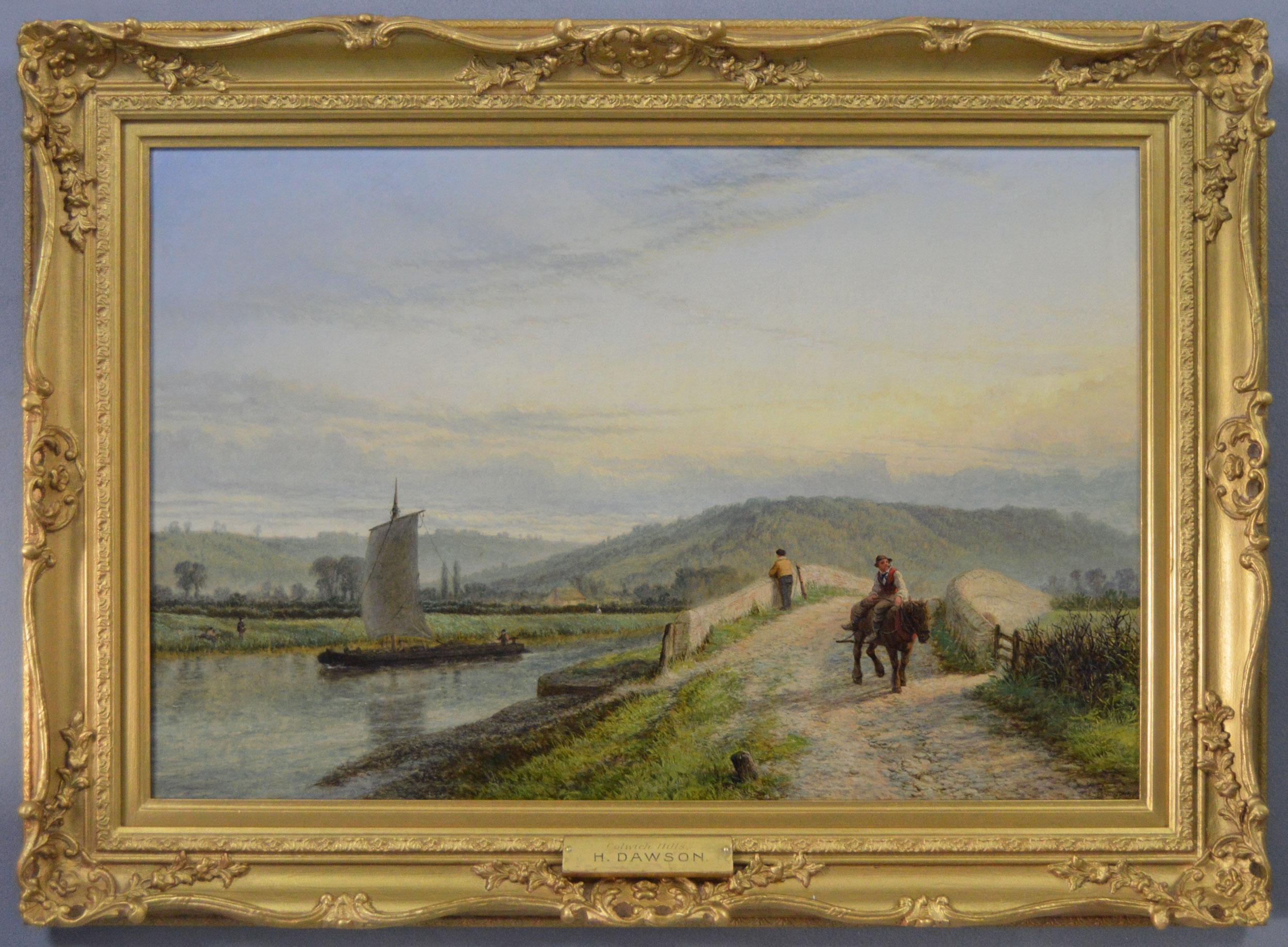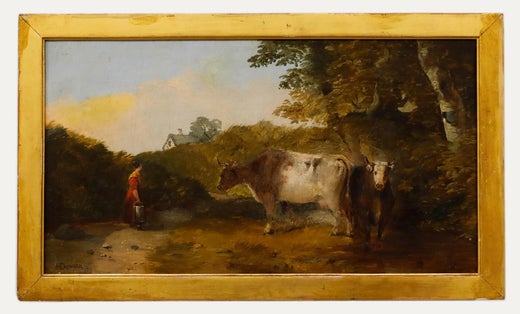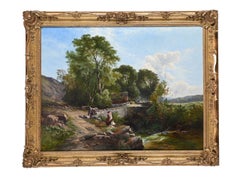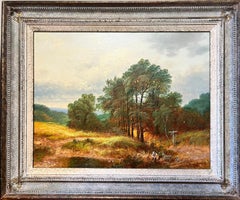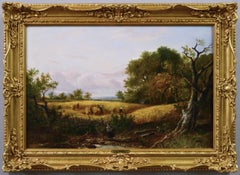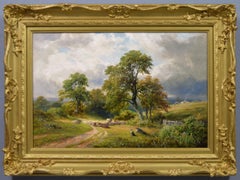Items Similar to Women in a Landscape - British Victorian art figurative landscape oil painting
Want more images or videos?
Request additional images or videos from the seller
1 of 16
Henry DawsonWomen in a Landscape - British Victorian art figurative landscape oil paintingCirca 1850
Circa 1850
$4,790
$5,987.5020% Off
£3,520
£4,40020% Off
€4,135.42
€5,169.2720% Off
CA$6,580.64
CA$8,225.8020% Off
A$7,346.67
A$9,183.3420% Off
CHF 3,849.54
CHF 4,811.9320% Off
MX$89,930.43
MX$112,413.0420% Off
NOK 48,889.24
NOK 61,111.5520% Off
SEK 46,096.35
SEK 57,620.4420% Off
DKK 30,863.03
DKK 38,578.7920% Off
Shipping
Retrieving quote...The 1stDibs Promise:
Authenticity Guarantee,
Money-Back Guarantee,
24-Hour Cancellation
About the Item
This charming Victorian landscape oil painting is by noted British artist Henry Dawson. It was painted circa 1850, when Dawson was working in London, producing some of his best works and exhibiting regularly at the Royal Academy and British Institute. Although a landscape, the portrait orientation emphasises the huge central tree and vast blue sky. that meets the distant landscape beyond. In the foreground, women are travelling a path with their cattle and sheep and one has stopped to collect water from a stream wile their dog excitedly looks on. A superb Victorian oil painting with great attention to detail and lovely soft tones.
Monogrammed lower right and indistinctly dated.
Provenance. Cornish estate.
Condition. Oil on Canvas, 24 inches by 20 inches and in good condition.
Frame. Housed in ornate gilt frame, 32 inches by 28 inches and in good condition.
Henry Dawson (1811-1878) was a British landscape painter. Born in Kingston upon Hull, Dawson went with his parents to Nottingham when he was still an infant and always regarded the latter as his native town. His parents were poor, and he began life in a Nottingham lace factory. But even while engaged in lace-making he continued to find time for art, and used to paint small pictures, which he sold at first for about half-a-crown each. In 1835 he gave up the lace trade and set up as an artist, his earliest patron being a hairdresser in Nottingham, who possessed a taste for art. In 1844 he removed to Liverpool, where after a time he got into greater repute, and received higher prices for his works. In 1849 he came with his family to London, and settled at Croydon, where some of his best pictures were painted. Among these may be reckoned 'The Wooden Walls of Old England,' exhibited at the British Institution in 1853, 'The Rainbow,' 'The Rainbow at Sea,' 'London Bridge,' and ' London at Sunrise.' With the exception of six lessons from Pyne received in 1838, Henry Dawson was entirely a self-taught artist, and his art shows much originality and careful realism. He studied nature for himself, but he seems in later life to have been moved by Turner's influence to try more brilliant effects than he had before dared. Many of his works indeed are very Turneresque in treatment, though he can scarcely be called an imitator of Turner, for he had a distinct style of his own. Henry Dawson, though painting much, and selling his pictures for high prices in his later life, remained, strange to say, very little known except to artists and connoisseurs until the large and very interesting collection of his works that was made for the Nottingham Exhibition in 1878 brought him wider fame. He died in December 1878, at Chiswick, where he had for some time.
Exhibited at the Liverpool Academy; elected associate 1846, Member 1847. Whilst living in London, exhibited 28 times at the Royal Academy between1838-74, also at the British Institute, SS and Portland Gallery.
- Creator:Henry Dawson (1811 - 1878, British)
- Creation Year:Circa 1850
- Dimensions:Height: 32 in (81.28 cm)Width: 28 in (71.12 cm)Depth: 2 in (5.08 cm)
- Medium:
- Movement & Style:
- Period:
- Condition:
- Gallery Location:London, GB
- Reference Number:1stDibs: LU853113420232
Henry Dawson
Although a student of James Baker Pyne (1800-1870), the majority of Henry Dawson’s art instruction came from studying the landscapes of J.M.W. Turner (1775-1851). Dawson’s fine draftsmanship and colouring earned him a considerable reputation among many influential British artists before he ever exhibited at the major London galleries. Between 1838 and 1875 Henry Dawson exhibited at the Royal Academy, the British Institution, and the Royal Society of British Artists, to which he was elected a full member in 1875. During this period, his fame earnt him the patronage of two of the most important art collectors of Victorian Britain; James Orrock and John Burton, owners of numerous paintings by J.M.W. Turner. Following the death of the latter in 1851, John Burton told Henry Dawson that his “powers are not equalled by any living or working man." In 2000 Dawson's 1857 painting of a sunset over ‘The New Houses of Parliament, Westminster’ sold at Phillips in London for £185,000. Today, works by Dawson feature in the collections of the Walker Gallery in Liverpool and the Victoria and Albert Museum in London.
About the Seller
5.0
Platinum Seller
Premium sellers with a 4.7+ rating and 24-hour response times
1stDibs seller since 2018
454 sales on 1stDibs
Typical response time: 1 hour
- ShippingRetrieving quote...Shipping from: London, United Kingdom
- Return Policy
Authenticity Guarantee
In the unlikely event there’s an issue with an item’s authenticity, contact us within 1 year for a full refund. DetailsMoney-Back Guarantee
If your item is not as described, is damaged in transit, or does not arrive, contact us within 7 days for a full refund. Details24-Hour Cancellation
You have a 24-hour grace period in which to reconsider your purchase, with no questions asked.Vetted Professional Sellers
Our world-class sellers must adhere to strict standards for service and quality, maintaining the integrity of our listings.Price-Match Guarantee
If you find that a seller listed the same item for a lower price elsewhere, we’ll match it.Trusted Global Delivery
Our best-in-class carrier network provides specialized shipping options worldwide, including custom delivery.More From This Seller
View AllCattle Watering in a Landscape - British 19th century art Victorian oil painting
By Samuel Bough
Located in London, GB
This lovely British Victorian landscape oil painting is attributed to noted artist Sam Bough. It was painted circa 1855 after Bough had moved to Hamilton Lanarkshire in Scotland to focus on painting landscapes along side fellow artist Alexander Frazer. The composition is several cattle watering in a stream under the boughs of an ancient tree. There is superb impasto, for example on the clouds and this is a charming 19th century oil painting.
Provenance. London estate.
Condition. Oil on canvas, 29 inches by 16 inches unframed and in good condition.
Frame. Housed in an ornate gilt Victorian frame, 36 inches by 23 inches framed and in good condition.
Samuel Bough RSA (1822–1878) was an English-born landscape painter who spent much of his career working in Scotland. He was born the third of five children in Abbey Street, Carlisle in northern England, the son of James Bough (1794-1845), a shoemaker, and Lucy Walker, a cook. He was raised in relative poverty, but with a keen encouragement in the arts. He was self-taught but mixed with local artists such as Richard Harrington and George Sheffield, and was strongly influenced by the work of Turner. After an unsuccessful attempt to live as an artist in Carlisle he obtained a job and as a theatre scenery painter in Manchester in 1845, later also working in Glasgow in the same role. Encouraged by Daniel Macnee to take up landscape painting he moved to Hamilton from 1851-4 and worked there with Alexander Fraser. In 1854 he moved to Port Glasgow to work on his technique of painting ships and harbours. His paintings were noted for their sensitivity to atmosphere and light, were often of cloudy shorelines and busy harbours. He also began supplementing his income by illustrating books, before moving to Edinburgh in 1855. On coming to Edinburgh he lived in a terraced house at 5 Malta Terrace in the Stockbridge area of the city. Following Turner's example, he became a skilful painter of seaports. He was buried in Dean Cemetery Edinburgh on 23 November 1878. The grave bears a bronze medallion of his head by William Brodie...
Category
1850s Victorian Landscape Paintings
Materials
Oil
$3,701 Sale Price
20% Off
Cattle and Drover in a Landscape - British Victorian art landscape oil painting
Located in London, GB
This gorgeous oil on canvas Victorian Old Master painting is by British artist Henry Jutsum. Painted circa 1850 the painting depicts a drover on horse back bringing up the rear behin...
Category
19th Century Old Masters Landscape Paintings
Materials
Oil
Dancers in a Landscape - British 19thC art figurative landscape oil painting
Located in London, GB
This lovely painting is a British Old Master late 18th century or early 19th-century oil painting by Thomas Barker of Bath. It is stylistically very similar to his other works of the...
Category
Early 19th Century Old Masters Landscape Paintings
Materials
Oil
Cadzow Forest Scotland - British mid 19thC art Scottish landscape oil painting
By Samuel Bough
Located in London, GB
This lovely British Victorian landscape oil painting is by noted artist Sam Bough. It was painted in 1855 after Bough had moved to Hamilton Lanarkshire in Scotland to focus on painting landscapes alongside fellow artist Alexander Frazer. The location is the ancient forest of Cadzow in Lanarkshire which they both favoured. The landscape is of a rough path through ancient oaks heading towards more dense forest with white cattle grazing to the right. A superb balanced composition and an excellent example of Bough's skill in landscape painting.
Signed lower left and dated 1855.
Provenance. Christie's stencil verso 519GG.
James Bourlet & Sons label verso.
Condition. Oil on canvas, 28 inches by 18 inches unframed and in good condition.
Frame. Housed in an ornate gilt Victorian frame, 35 inches by 25 inches framed and in good condition.
Samuel Bough RSA (1822–1878) was an English-born landscape painter who spent much of his career working in Scotland. He was born the third of five children in Abbey Street, Carlisle in northern England, the son of James Bough (1794-1845), a shoemaker, and Lucy Walker, a cook. He was raised in relative poverty, but with a keen encouragement in the arts. He was self-taught but mixed with local artists such as Richard Harrington and George Sheffield, and was strongly influenced by the work of Turner. After an unsuccessful attempt to live as an artist in Carlisle he obtained a job and as a theatre scenery painter in Manchester in 1845, later also working in Glasgow in the same role. Encouraged by Daniel Macnee to take up landscape painting he moved to Hamilton from 1851-4 and worked there with Alexander Fraser. In 1854 he moved to Port Glasgow to work on his technique of painting ships and harbours. His paintings were noted for their sensitivity to atmosphere and light, were often of cloudy shorelines and busy harbours. He also began supplementing his income by illustrating books, before moving to Edinburgh in 1855. On coming to Edinburgh he lived in a terraced house at 5 Malta Terrace in the Stockbridge area of the city. Following Turner's example, he became a skil ful painter of seaports. He was buried in Dean Cemetery Edinburgh on 23 November 1878. The grave bears a bronze medallion of his head by William Brodie...
Category
Mid-19th Century Realist Landscape Paintings
Materials
Oil
$8,654 Sale Price
20% Off
A Stream in the Forest - British Victorian 1859 art landscape oil painting
By George Cole
Located in London, GB
A fine and very detailed large Victorian British landscape painting. Painted in oil on canvas it is by listed and exhibited Victorian artist George Cole, dated 1859. A wonderful larg...
Category
19th Century Realist Landscape Paintings
Materials
Oil
$6,314 Sale Price
20% Off
Landscape with Cattle - Surrey - British Victorian art 19th century oil painting
By George William Mote
Located in London, GB
This charming Victorian landscape oil painting is by noted prolific exhibited British artist George William Mote. Mote was very fond of painting landscapes in Surrey and this is a pa...
Category
1880s Victorian Landscape Paintings
Materials
Oil
You May Also Like
19th century English Victorian oil landscape with figures, a stream and trees
By Henry John Boddington
Located in Woodbury, CT
Henry John Boddington.
19th century English landscape with figures by a riverside.
Simply one of the finest quality English landscape Ive ever had the pleasure of owning .
This i...
Category
1850s Victorian Landscape Paintings
Materials
Canvas, Oil
Traditional English Oil Painting Rural Workers by Lake in Landscape
Located in Cirencester, Gloucestershire
Country Landscape Scene With Figures
Andrew Grant- Curtis (20th Century British working in the Victorian style)
signed oil painting on canvas, framed
framed: 19 x 23 inches
canvas: 1...
Category
20th Century Victorian Landscape Paintings
Materials
Oil
19th Century landscape oil painting of figures harvesting
By Joseph Thors
Located in Nr Broadway, Worcestershire
Joseph Thors
British, (1835-1920)
Harvest Time
Oil on canvas, signed
Image size: 19.25 inches x 29.25 inches
Size including frame: 26.25 inches x 36.25 inches
This wonderfully deta...
Category
19th Century Victorian Landscape Paintings
Materials
Canvas, Oil
19th Century landscape oil painting of a shepherd & flock in a country lane
By George Turner
Located in Nr Broadway, Worcestershire
George Turner
British, (1843-1910)
Near Tonge, Leicestershire
Oil on canvas, signed
Image size: 15.25 inches x 23.25 inches
Size including frame: 22.75 inches x 30.75 inches
A cha...
Category
19th Century Victorian Landscape Paintings
Materials
Canvas, Oil
19th Century river landscape oil painting of Colwich Hills
By Henry Dawson
Located in Nr Broadway, Worcestershire
Henry Dawson
British, (1811-1878)
Colwich Hills from the Bridge at Great Haywood
Oil on canvas, signed & dated 1860
Image size: 19.5 inches x 29.5 inches
Size including frame: 27 inches x 37 inches
A wonderful painting of Colwich Hills from the bridge at Great Harwood, Staffordshire by Henry Dawson. A man can be seen riding a horse over the bridge as another figure looks across the water towards the hills. Meanwhile, a barge sails along the canal past two fishermen. The bridge depicted in this painting lies over the canal junction of Great Haywood, a short distance away from Colwich. This junction was built to join the Grand Union Canal to the Staffordshire and Worcestershire Canals. Both the bridge and junction are still in use today and the view of the hills remains relatively unchanged.
Henry Dawson was a landscape artist born in Hull on 3 April, 1811 to William Dawson and Hannah Shardlow. The family moved to Nottingham when he was still an infant. He is known to have spent time at the national school in Nottingham, however, due to family circumstances had to leave school to start work at an early age in the lace industry. He was largely self-taught and painted during his spare time. Around 1835, he left lace making to work full time as an artist. He studied under James Baker Pyne (1800-1870) in 1838 and in the same year made his debut at the Royal Academy, exhibiting a number of works there until 1871.He also exhibited at the British Institute from 1841 and also at the Liverpool Academy, where he was elected an associate in 1846 and a Member in 1847.
He married Elizabeth Whittle in Nottingham in 1840 and they lived in Mansfield Road, Nottingham where the first of their children were born. Two of his children, Henry Thomas Dawson (1841-1918) and Alfred Dawson (1843-1931) also became artists as did his grandson Montague Dawson (1895-1973). Although he achieved some success in Nottingham, for financial reasons he decided to move his family to Liverpool, where they stayed from 1845 until 1849. He moved again for similar reasons to Croydon in Surrey living at Middle Heath Lane and from 1854 he lived in Thorpe Green, Chertsey at Prospect Cottage. Being closer to the capital helped enhance his reputation and inspired by Turner he began to produce seascapes, riverscapes and coastal scenes often featuring architectural focal points. Dawson continued to travel around the country to paint the landscapes and coasts of England, frequently including castles such as this fine example. Around 1863, he moved to The Cedars in Chiswick where he spent his final years until his death on 13 December, 1878.
His work is represented in many public art collections including the Birmingham Museum, Bury Art Museum, Ferens Art Gallery, Leicester Museum, Nottingham City Museum, Victoria & Albert Museum, Wednesbury Museum, Sheffield Museum, Wolverhampton Art Gallery and the York Art Gallery.
Presentation: The painting is housed in a new English made gilt frame which is in excellent condition.
Condition: As with all of our original antique oil paintings, this work is offered in ready to hang gallery condition, having just been professionally cleaned, restored and revarnished.
© Benton Fine Art
Category
19th Century Landscape Paintings
Materials
Canvas, Oil
19th Century Scottish river landscape oil painting of Glen Falloch
By Sidney Richard Percy
Located in Nr Broadway, Worcestershire
Sidney Richard Percy
British, (1821-1886)
Glen Falloch
Oil on canvas, signed & dated (18)69
Image size: 23.5 inches x 37.5 inches
Size including frame: 29.5 inches x 43.5 inches
Provenance: MacConnal-Mason & Son Ltd
A superb Scottish landscape painting of Glen Falloch by Sidney Richard Percy. The work is typical of his oeuvre and includes seated figures, a fisherman, cattle and sheep. Glen Falloch is a valley in the Argyll and Bute area of Scotland. It lies between Crianlarich and Loch Lomand. The river Falloch, which is featured in the painting, flows through it before entering Loch Lomand.
Sidney Richard Percy was born Sidney Richard Williams, on the 22 March, 1822 the fifth son of the artist Edward Williams Snr (1781–1855) and Ann Hildebrandt. His brothers Edward Charles (1807–1881), Henry John Boddington (1811–1865), George Augustus (1814–1901), Arthur Gilbert (1819–1895) and Alfred Walter Williams...
Category
19th Century Victorian Landscape Paintings
Materials
Canvas, Oil
More Ways To Browse
Lace Framed Art
Dior Patron
Very Large Antique Landscape Oil Paintings
Rainbow Landscape
Lace Oil Painting
Sheep And Landscape Framed Oil Paintings
Antique Sheeps Paintings Landscaping
1835 Portrait
Antique Wooden Dog
British Sheep Painting
Antique Nottingham
Sheep Dog
Cattle Watering Oil Painting
Large 19th Century Dog Painting
Antique Sunrise Painting
Large Antique Oil Painting Sheep
Victorian Oil Paintings Of Sheep
Dior Blue Monogram
